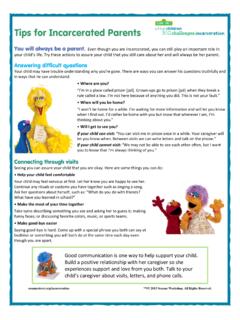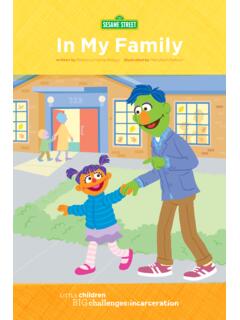Transcription of Sink or Float - Sesame Street
1 Sink or FloatWELCOME, EDUCATOR! You and the children you work with are about to embark on an engaging multimedia experience exploring concepts in Science, Technology, Engineering, and Math (STEM). Sesame Street Little Discoverers: Big Fun with Science, Math, and More is a resource to help you discover exciting new ways to build on children s natural fascination with STEM concepts. In this topic, children will investigate which objects sink or Float in water. HELP CHILDREN TALK ABOUT SINKING AND FLOATING: Some objects sink and others Float . An object that sinks goes below the surface of the water. An object that floats stays above the surface of the water. Weight is one factor in sinking and floating, but it is not the cause. Some children may think an object sinks or floats because an object is heavy or light.
2 But not all heavy objects sink, and not all light objects Float . For example, large ships are very heavy but they Float . Also, a pound of feathers will Float and a pound of bricks will sink. Young children may not be ready to understand why objects sink and why they Float , but they can make hypotheses and observe what happens to objects that are placed in the VOCABULARY analyzing: considering information gathered during an experimentfloat: to stay above the surface of the waterinvestigating: gathering information by observing or testing material: what something is made ofobserving: using our senses to gather informationreflecting: considering observations about the experiment reporting: telling others about the experiment sink: to go below the surface of the water For more fun ideas, videos, and games, check out on your computer or mobile /TM 2013 Sesame Workshop.
3 All Rights Reserved. Page 1 Major support provided by CA Technologies. Generous support provided by the S. D. Bechtel, Jr. Foundation and the Heising-Simons Foundation. SINK OR FLOATB oats that Sink and FloatGOALI nvestigate ways to sculpt clay into boats that can changing the shape of clay affect whether it sinks or floats? TIME20 30 minutes MATERIALS 1 water table, basin, or bucket filled with water 1 ball of oil-based sculpting clay per child (make sure you re not using water-based clay) View and Do Chart (one per child) crayons LET S WATCH: MURRAY EXPERIMENT: BOATS In the video, Murray and his friends try to make boats that Float . They use aluminum foil to make boats of different shapes and then add large, round, metal washers to see how many washers each boat can hold and still Float .
4 Murray and his friends find out that a boat s shape affects its ability to S TALK ABOUT ITAfter you watch the video together, ask some questions to prompt a discussion. What did Murray and his friends try to do with the aluminum foil? How were the sinking and floating boats different? If you could design a boat that floats, what would it look like? LET S DO AN ACTIVITY: 1. Give each child a ball of sculpting clay, and ask them to roll the clay into Have children make a hypothesis about whether they think the clay ball will sink or Float , then place the balls in the water. 3. Discuss what happens: Did the balls sink or Float ? 4. Say, I wonder what we could do with the clay to make it Float ? Ask for ideas. 5. Say, Let s try to make different kinds of boats with our clay.
5 We ll see if we can create some boat shapes that Float . 6. During the investigation, ask questions: What do you observe about the boat s shape, size, and weight? What shapes seem to sink? What shapes seem to Float ? 7. Have children record results on the View and Do /TM 2013 Sesame Workshop. All Rights Reserved. Page 2 Major support provided by CA Technologies. Generous support provided by the S. D. Bechtel, Jr. Foundation and the Heising-Simons Foundation. SINK OR FLOATB oats that Sink and FloatHave each child draw one boat design that sinks, and one that floats. Check to see that children correctly position their boats on top or below the surface of the water in their /TM 2013 Sesame Workshop. All Rights Reserved. Page 3 Major support provided by CA Technologies. Generous support provided by the S.
6 D. Bechtel, Jr. Foundation and the Heising-Simons Foundation. SINK OR FLOATWhat Sinks? What Floats?In this activity, children will explore what sinks and what floats by testing different Ask children, Which items do you think will sink? Which do you think will Float ? 2. Have children test the objects by putting them in the water one at a After an item is tested, have a child put the object into the SINK container or Float After all the materials are tested, count how many objects sink and how many Float . Then, have children record the information with pictures onto the chart. 5. Ask, What did the sinking objects have in common? What did the floating objects have in common? Guide the children to discuss the shape and material of each object. 6. If there is time, help children find other objects to test.
7 Before they put an object in the water, have them make a hypothesis about whether they think it will sink or Float based on what they just observed. TUBE EXPLORATION Test a paper towel tube. Will it sink or Float ? Now wrap another paper towel tube carefully in aluminum foil so that it is watertight. Will it Float ? What happens if children open the foil-covered tube and place weights inside and rewrap it? Will it still Float ?GOALO bserve that some objects sink and some do you notice about objects that sink and objects that Float ?TIME15 30 minutesMATERIALSFor each small group of children: 1 water table or clear basin or bucket of water. 1 bag of 6 to 12 different small objects that can get wet (suggested items that sink: rock, metal spoon, clay ball, rubber band, blocks, baseball; suggested items that Float : pencil, leaf, popsicle stick, aluminum foil, plastic math counters, paper index card, plastic bottle) 2 large containers, one labeled SINK and one labeled Float Activity Chart (one per child) /TM 2013 Sesame Workshop.
8 All Rights Reserved. Page 4 Major support provided by CA Technologies. Generous support provided by the S. D. Bechtel, Jr. Foundation and the Heising-Simons Foundation. SINK OR FLOATWhat Sinks? What Floats?Have children draw the objects that sink or /TM 2013 Sesame Workshop. All Rights Reserved. Page 5 Major support provided by CA Technologies. Generous support provided by the S. D. Bechtel, Jr. Foundation and the Heising-Simons Foundation. Sink or FloatSesame Street Little Discoverers: Big Fun with Science, Math, and More is a resource to help you and your child explore STEM. Remember, it s okay to not know the answers to all of her questions. Model a sense of curiosity by saying something like, That s a great question! I don t know the answer but let s find out together. HELLO, FAMILIES!Your child is full of curiosity.
9 She is always observing, questioning, testing her thinking, and collecting information. These are important critical-thinking and problem- solving skills that help set her up for success in Science, Technology, Engineering, and Math (STEM). HELP YOUR CHILD TALK ABOUT SINKING AND FLOATING Something that sinks goes below the top of the water. Something that floats stays on top of the water. All objects are made of different materials. TRY THIS AT HOMEPick and choose the activities that work best for you and your child. Let s Talk. Use the words sink, Float , and materials as many times as you can this week! Say things like, I wonder if the soap will Float in the tub. What material is this toy made of? Explore in the Tub. During bath time, provide plastic containers and cups, combs, blocks, metal spoons, and sponges for your child to explore which objects sink or Float .
10 Guess which shapes and materials will sink or Float before you drop them into the water. Try dropping a cup that s empty, and then fill it with water to see what happens. In the Kitchen. Give your child a bowl to help you wash fruits like an apples, oranges, lemons, or limes. Ask your child to make a hypothesis: Which ones will sink and which ones will Float ? Investigate by placing them in the water. /TM 2013 Sesame Workshop. All Rights Reserved. Page 6 Major support provided by CA Technologies. Generous support provided by the S. D. Bechtel, Jr. Foundation and the Heising-Simons Foundation. For more fun ideas, videos, and games, check out on your computer or mobile device. SINK OR FLOATMake It Sink!TUBE EXPLORATIONUse paper towel tubes to explore sinking and floating. Have your child investigate whether a tube will sink or Float in water.












